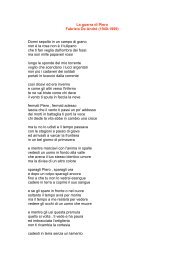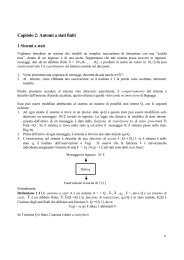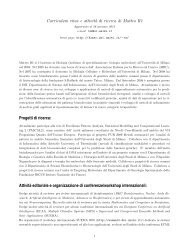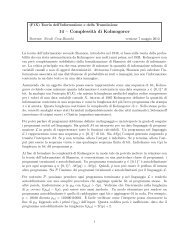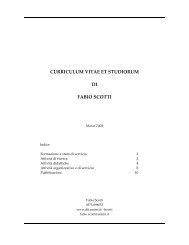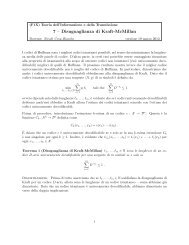Ensembles based on random projections to improve the accuracy of ...
Ensembles based on random projections to improve the accuracy of ...
Ensembles based on random projections to improve the accuracy of ...
You also want an ePaper? Increase the reach of your titles
YUMPU automatically turns print PDFs into web optimized ePapers that Google loves.
<str<strong>on</strong>g>Ensembles</str<strong>on</strong>g> <str<strong>on</strong>g>based</str<strong>on</strong>g> <strong>on</strong> <strong>random</strong> projecti<strong>on</strong>s <strong>to</strong><br />
<strong>improve</strong> <strong>the</strong> <strong>accuracy</strong> <strong>of</strong> clustering algorithms<br />
Alber<strong>to</strong> Bert<strong>on</strong>i and Giorgio Valentini<br />
DSI, Dipartimen<strong>to</strong> di Scienze dell’ Informazi<strong>on</strong>e,<br />
Università degli Studi di Milano,<br />
Via Comelico 39, 20135 Milano, Italia.<br />
{bert<strong>on</strong>i,valentini}@dsi.unimi.it<br />
Abstract. We present an algorithmic scheme for unsupervised cluster<br />
ensembles, <str<strong>on</strong>g>based</str<strong>on</strong>g> <strong>on</strong> <strong>random</strong>ized projecti<strong>on</strong>s between metric spaces, by<br />
which a substantial dimensi<strong>on</strong>ality reducti<strong>on</strong> is obtained. Multiple clusterings<br />
are performed <strong>on</strong> <strong>random</strong> subspaces, approximately preserving<br />
<strong>the</strong> distances between <strong>the</strong> projected data, and <strong>the</strong>n <strong>the</strong>y are combined<br />
using a pairwise similarity matrix; in this way <strong>the</strong> <strong>accuracy</strong> <strong>of</strong> each “base”<br />
clustering is maintained, and <strong>the</strong> diversity between <strong>the</strong>m is <strong>improve</strong>d.<br />
The proposed approach is effective for clustering problems characterized<br />
by high dimensi<strong>on</strong>al data, as shown by our preliminary experimental<br />
results.<br />
1 Introducti<strong>on</strong><br />
Supervised multi-classifiers systems characterized <strong>the</strong> early development <strong>of</strong> ensemble<br />
methods [1, 2]. Recently this approach has been extended <strong>to</strong> unsupervised<br />
clustering problems [3, 4].<br />
In a previous work we proposed stability measures that make use <strong>of</strong> <strong>random</strong><br />
projecti<strong>on</strong>s <strong>to</strong> assess cluster reliability [5], extending a previous approach [6]<br />
<str<strong>on</strong>g>based</str<strong>on</strong>g> <strong>on</strong> an unsupervised versi<strong>on</strong> <strong>of</strong> <strong>the</strong> <strong>random</strong> subspace method [7].<br />
In this paper we adopt <strong>the</strong> same approach <strong>to</strong> develop cluster ensembles <str<strong>on</strong>g>based</str<strong>on</strong>g><br />
<strong>on</strong> <strong>random</strong> projecti<strong>on</strong>s. Unfortunately, a deterministic projecti<strong>on</strong> <strong>of</strong> <strong>the</strong> data in<strong>to</strong><br />
relatively low dimensi<strong>on</strong>al spaces may introduce relevant dis<strong>to</strong>rti<strong>on</strong>s, and, as a<br />
c<strong>on</strong>sequence, <strong>the</strong> clustering in <strong>the</strong> projected space may results c<strong>on</strong>sistently different<br />
from <strong>the</strong> clustering in <strong>the</strong> original space. For <strong>the</strong>se reas<strong>on</strong>s we propose <strong>to</strong><br />
perform multiple clusterings <strong>on</strong> <strong>random</strong>ly chosen projected subspaces, approximately<br />
preserving <strong>the</strong> distances between <strong>the</strong> examples, and <strong>the</strong>n combining <strong>the</strong>m<br />
<strong>to</strong> generate <strong>the</strong> final ”c<strong>on</strong>sensus” clustering.<br />
The next secti<strong>on</strong> introduces basic c<strong>on</strong>cepts about <strong>random</strong>ized embeddings<br />
between metric spaces. Sect. 3 presents <strong>the</strong> Randomized embedding clustering<br />
(RE-Clust) ensemble algorithm, and Sect. 4 show <strong>the</strong> results <strong>of</strong> <strong>the</strong> applicati<strong>on</strong><br />
<strong>of</strong> <strong>the</strong> ensemble method <strong>to</strong> high dimensi<strong>on</strong>al syn<strong>the</strong>tic data. The discussi<strong>on</strong> <strong>of</strong><br />
<strong>the</strong> results and <strong>the</strong> outgoing developments <strong>of</strong> <strong>the</strong> present work end <strong>the</strong> paper.
2 Randomized embeddings<br />
2.1 Randomized embeddings with low dis<strong>to</strong>rti<strong>on</strong>.<br />
Dimensi<strong>on</strong>ality reducti<strong>on</strong> may be obtained by mapping points from a high <strong>to</strong><br />
a low-dimensi<strong>on</strong>al space: µ : Rd → Rd′ , with d ′ < d, approximately preserving<br />
some characteristics, i.e. <strong>the</strong> distances between points In this way, algorithms<br />
whose results depend <strong>on</strong>ly <strong>on</strong> <strong>the</strong> distances ||xi − xj|| could be applied <strong>to</strong> <strong>the</strong><br />
compressed data µ(X), giving <strong>the</strong> same results, as in <strong>the</strong> original input space. In<br />
this c<strong>on</strong>text <strong>random</strong>ized embeddings with low dis<strong>to</strong>rti<strong>on</strong> represent a key c<strong>on</strong>cept.<br />
A <strong>random</strong>ized embedding between Rd and Rd′ with dis<strong>to</strong>rti<strong>on</strong> 1+ɛ, (0 < ɛ ≤ 1/2)<br />
and failure probability P is a distributi<strong>on</strong> probability <strong>on</strong> <strong>the</strong> linear mapping<br />
µ : Rd → Rd′ , such that, for every pair p, q ∈ Rd , <strong>the</strong> following property holds<br />
with probability ≥ 1 − P :<br />
1 ||µ(p) − µ(q)||<br />
≤ ≤ 1 + ɛ (1)<br />
1 + ɛ ||p − q||<br />
The main result <strong>on</strong> <strong>random</strong>ized embedding is due <strong>to</strong> Johns<strong>on</strong> and Lindenstrauss<br />
[8], who proved <strong>the</strong> following:<br />
Johns<strong>on</strong>-Lindenstrauss (JL) lemma: Given a set S with |S| = n <strong>the</strong>re exists a<br />
1 + ɛ-dis<strong>to</strong>rti<strong>on</strong> embedding in<strong>to</strong> Rd′ with d ′ = c log n/ɛ2 , where c is a suitable<br />
c<strong>on</strong>stant.<br />
The embedding exhibited in [8] c<strong>on</strong>sists in <strong>random</strong> projecti<strong>on</strong>s from Rd in<strong>to</strong><br />
Rd′ , represented by matrices d ′ × d with <strong>random</strong> orth<strong>on</strong>ormal vec<strong>to</strong>rs. Similar<br />
results may be obtained by using simpler embeddings [9], represented through<br />
<strong>random</strong> d ′ × d matrices P = 1/ √ d ′ (rij), where rij are <strong>random</strong> variables such<br />
that:<br />
E[rij] = 0, V ar[rij] = 1<br />
For sake <strong>of</strong> simplicity, we call <strong>random</strong> projecti<strong>on</strong>s even this kind <strong>of</strong> embeddings.<br />
2.2 Random projecti<strong>on</strong>s.<br />
Examples <strong>of</strong> <strong>random</strong>ized maps, represented trough d ′ × d matrices P such that<br />
<strong>the</strong> columns <strong>of</strong> <strong>the</strong> ”compressed” data set DP = P D have approximately <strong>the</strong><br />
same distance are:<br />
1. Plus-Minus-One (PMO) <strong>random</strong> projecti<strong>on</strong>s: represented by matrices P =<br />
1/ √ d ′ (rij), where rij are uniformly chosen in {−1, 1}, such that P rob(rij =<br />
1) = P rob(rij = −1) = 1/2. In this case <strong>the</strong> JL lemma holds with c 4.<br />
2. Random Subspace (RS) [7]: represented by d ′ × d matrices P = d/d ′ (rij),<br />
where rij are uniformly chosen with entries in {0, 1}, and with exactly <strong>on</strong>e<br />
”1” per row and at most <strong>on</strong>e ”1” per column. Even if RS subspaces can be<br />
quickly computed, <strong>the</strong> do not satisfy <strong>the</strong> JL lemma.
3 Randomized embedding cluster ensembles<br />
C<strong>on</strong>sider a data set X = {x1, x2, . . . , xn}, where xi ∈ R d , (1 ≤ i ≤ n); a subset<br />
A ⊆ {1, 2, . . . , n} univocally individuates a subset <strong>of</strong> examples {xj|j ∈ A} ⊆<br />
X. The data set X may be represented as a d × n matrix D, where columns<br />
corresp<strong>on</strong>d <strong>to</strong> <strong>the</strong> examples, and rows corresp<strong>on</strong>d <strong>to</strong> <strong>the</strong> ”comp<strong>on</strong>ents” <strong>of</strong> <strong>the</strong><br />
examples x ∈ X. A k-clustering C <strong>of</strong> X is a list C =< A1, A2, . . . , Ak >, with<br />
Ai ⊆ {1, 2, . . . , n} and such that Ai = {1, . . . , n}. A clustering algorithm C<br />
is a procedure that, having as input a data set X and an integer k, outputs a<br />
k-clustering C <strong>of</strong> X: C(X, k) =< A1, A2, . . . , Ak >.<br />
The main ideas behind <strong>the</strong> proposed cluster ensemble algorithm RE-Clust<br />
(acr<strong>on</strong>ym for Randomized Embedding Clustering) are <str<strong>on</strong>g>based</str<strong>on</strong>g> <strong>on</strong> data compressi<strong>on</strong>,<br />
and generati<strong>on</strong> and combinati<strong>on</strong> <strong>of</strong> multiple ”base” clusterings. Indeed<br />
at first data are <strong>random</strong>ly projected from <strong>the</strong> original <strong>to</strong> lower dimensi<strong>on</strong>al subspaces,<br />
using projecti<strong>on</strong>s described in Sect 2.2 in order <strong>to</strong> approximately preserve<br />
<strong>the</strong> distances between <strong>the</strong> examples. Then multiple clusterings are performed <strong>on</strong><br />
multiple instances <strong>of</strong> <strong>the</strong> projected data, and a similarity matrix between pairs<br />
<strong>of</strong> examples is used <strong>to</strong> combine <strong>the</strong> multiple clusterings.<br />
The high level pseudo-code <strong>of</strong> <strong>the</strong> ensemble algorithm scheme is <strong>the</strong> following:<br />
RE-Clust algorithm:<br />
Input:<br />
– a data set X = {x1, x2, . . . , xn}, represented by a d × n D matrix.<br />
– an integer k (number <strong>of</strong> clusters)<br />
– a real ɛ > 0 (dis<strong>to</strong>rti<strong>on</strong> level)<br />
– an integer c (number <strong>of</strong> clusterings)<br />
– two clustering algorithms C and Ccom<br />
– a procedure that realizes a <strong>random</strong>ized map µ<br />
begin algorithm<br />
(1) d ′ = 2 ·<br />
2 log n+log c<br />
ɛ 2<br />
<br />
(2) For each i, j ∈ {1, . . . , n} do Mij = 0<br />
(3) Repeat for t = 1 <strong>to</strong> c<br />
(4) Pt = Generate projecti<strong>on</strong> matrix (d, d ′ )<br />
(5) Dt = Pt · D<br />
(6) < C (t)<br />
1<br />
, C(t)<br />
2<br />
, . . . , C(t)<br />
k >= C(Dt, k)<br />
(7) For each i, j ∈ {1, . . . , n}<br />
M (t) 1 k<br />
ij = k s=1 I(i ∈ C(t) s ) · I(j ∈ C (t)<br />
s )<br />
end repeat<br />
P c<br />
M (t)<br />
t=1 (8)M = c<br />
(9) < A1, A2, . . . , Ak >= Ccom(M, k)<br />
end algorithm.<br />
Output:<br />
– <strong>the</strong> final clustering C =< A1, A2, . . . , Ak >
In <strong>the</strong> first step <strong>of</strong> <strong>the</strong> algorithm, given a dis<strong>to</strong>rti<strong>on</strong> level ɛ, <strong>the</strong> dimensi<strong>on</strong> d ′<br />
for <strong>the</strong> compressed data is computed according <strong>to</strong> <strong>the</strong> JL lemma.<br />
At each iterati<strong>on</strong> <strong>of</strong> <strong>the</strong> main repeat loop (step 3-7), <strong>the</strong> procedure<br />
Generate projecti<strong>on</strong> matrix outputs a projecti<strong>on</strong> matrix Pt according <strong>to</strong> <strong>the</strong><br />
<strong>random</strong>ized embedding µ, and a projected data set Dt = Pt · D is generated;<br />
, . . . , C(t) > is computed by calling C,<br />
<strong>the</strong> corresp<strong>on</strong>ding clustering < C (t)<br />
1<br />
, C(t)<br />
2<br />
k<br />
and a M (t) similarity matrix is built. The similarity matrix M (t) associated <strong>to</strong><br />
a clustering C =< C (t)<br />
1 , C(t) 2 , . . . , C(t)<br />
k > is a n × n matrix such that:<br />
M (t)<br />
ij<br />
= 1<br />
k<br />
k<br />
s=1<br />
I(i ∈ C (t)<br />
s ) · I(j ∈ C (t)<br />
s ) (2)<br />
where I is is <strong>the</strong> characteristic functi<strong>on</strong> <strong>of</strong> <strong>the</strong> set Cs. After step (8), Mij denotes<br />
<strong>the</strong> frequency by which <strong>the</strong> examples i and j occur in <strong>the</strong> same cluster across<br />
multiple clusterings. The final clustering is performed by applying <strong>the</strong> clustering<br />
algorithm Ccom <strong>to</strong> <strong>the</strong> main similarity matrix M. Choosing different <strong>random</strong><br />
projecti<strong>on</strong>s we may generate different RE-Clust ensembles (e.g. PMO and RS<br />
cluster ensembles).<br />
4 Experimental results<br />
In this secti<strong>on</strong> we present some preliminary experimental results with <strong>the</strong> RE-<br />
Clust ensemble algorithm. The Ward’s hierarchical agglomerative clustering algorithm<br />
[10] has been applied as ”base” clustering algorithm.<br />
4.1 Experimental envir<strong>on</strong>ment<br />
Syn<strong>the</strong>tic data generati<strong>on</strong> We experimented with 2 different sample genera<strong>to</strong>rs,<br />
whose samples are distributed according <strong>to</strong> different mixtures <strong>of</strong> high<br />
dimensi<strong>on</strong>al gaussian distributi<strong>on</strong>s.<br />
Sample1 is a genera<strong>to</strong>r for 5000-dimensi<strong>on</strong>al data sets composed by 3 clusters.<br />
The elements <strong>of</strong> each cluster are distributed according <strong>to</strong> a spherical gaussian<br />
with standard deviati<strong>on</strong> equal <strong>to</strong> 3. The first cluster is centered in 0, that is a<br />
5000-dimensi<strong>on</strong>al vec<strong>to</strong>r with all zeros. The o<strong>the</strong>r two clusters are centered in<br />
0.5e and −0.5e, where e is a vec<strong>to</strong>r with all 1.<br />
Sample2 is a a genera<strong>to</strong>r for 6000-dimensi<strong>on</strong>al data sets composed by 5 clusters<br />
<strong>of</strong> data normally distributed. The diag<strong>on</strong>al <strong>of</strong> <strong>the</strong> covariance matrix for all<br />
<strong>the</strong> classes has its element equal <strong>to</strong> 1 (first 1000 elements) and equal <strong>to</strong> 2 (last<br />
5000 elements). The first 1000 variables <strong>of</strong> <strong>the</strong> five clusters are respectively centered<br />
in 0, e, −e, 5e, −5e. The remaining 5000 variables are centered in 0 for<br />
all clusters.<br />
For each genera<strong>to</strong>r, we c<strong>on</strong>sidered 30 different <strong>random</strong> samples each respectively<br />
composed by 60, 100 examples (that is, 20 examples per class).
Error<br />
0.0 0.1 0.2 0.3<br />
Error<br />
0.00 0.02 0.04 0.06 0.08<br />
PMO ensemble<br />
RS ensemble<br />
single<br />
1.05 1.10 1.15 1.20 1.25 1.30 1.35 1.40<br />
PMO ensemble<br />
RS ensemble<br />
single<br />
dis<strong>to</strong>rti<strong>on</strong><br />
(a)<br />
1.10 1.15 1.20 1.25 1.30 1.35 1.40 1.45<br />
dis<strong>to</strong>rti<strong>on</strong><br />
(b)<br />
Fig. 1. Comparis<strong>on</strong> <strong>of</strong> mean errors between single hierarchical clustering, PMO and<br />
RS ensembles with different 1 + ɛ dis<strong>to</strong>rti<strong>on</strong>s. For ensembles, error bars for <strong>the</strong> 99%<br />
c<strong>on</strong>fidence interval are represented, while for single hierarchical clustering <strong>the</strong> 99%<br />
c<strong>on</strong>fidence interval is represented by <strong>the</strong> dotted lines above and below <strong>the</strong> horiz<strong>on</strong>tal<br />
dash-dotted line. (a) Sample1 data set (b) sample2<br />
Experimental setup We compared classical single hierarchical clustering algorithm<br />
with our ensemble approach c<strong>on</strong>sidering PMO and RS <strong>random</strong> projecti<strong>on</strong>s<br />
(Sect. 2.2). We used 30 different realizati<strong>on</strong>s for each syn<strong>the</strong>tic data set,<br />
using each time 20 clusterings for both PMO and RS ensembles. For each PMO<br />
and RS ensemble we experimented with different dis<strong>to</strong>rti<strong>on</strong>s, corresp<strong>on</strong>ding <strong>to</strong><br />
ɛ ∈ [0.06, 0.5].<br />
We implemented <strong>the</strong> ensemble algorithms and <strong>the</strong> scripts used for <strong>the</strong> experiments<br />
in <strong>the</strong> R language (code is freely available from <strong>the</strong> authors).
4.2 Results<br />
With sample1 (Fig.1 (a)) for 1.10 dis<strong>to</strong>rti<strong>on</strong>, that corresp<strong>on</strong>ds <strong>to</strong> projecti<strong>on</strong>s from<br />
<strong>the</strong> original 5000 in<strong>to</strong> a 3407 dimensi<strong>on</strong>al subspace, RE-Clust ensembles perform<br />
significantly better than single clustering. Indeed PMO ensembles achieve<br />
a 0.017 ± 0.010 mean error over 30 different realizati<strong>on</strong>s from sample1, and RS<br />
ensembles a 0.018 ± 0.011 mean error against a 0.082 ± 0.015 mean error for<br />
single hierarchical clustering. Also with an estimated 1.20 dis<strong>to</strong>rti<strong>on</strong> (with a<br />
corresp<strong>on</strong>ding subspace dimensi<strong>on</strong> equal <strong>to</strong> 852) we obtain significantly better<br />
results with both PMO and RS ensembles.<br />
With sample2 (Fig.1 (b)) <strong>the</strong> difference is significant <strong>on</strong>ly for 1.10 dis<strong>to</strong>rti<strong>on</strong>,<br />
while for larger dis<strong>to</strong>rti<strong>on</strong>s <strong>the</strong> difference is not significant and, <strong>on</strong> <strong>the</strong> c<strong>on</strong>trary,<br />
with 1.4 dis<strong>to</strong>rti<strong>on</strong> RE-Clust ensembles perform worse than single clustering.<br />
This may be due both <strong>to</strong> <strong>the</strong> relatively high dis<strong>to</strong>rti<strong>on</strong> induced by <strong>the</strong> <strong>random</strong>ized<br />
embedding and <strong>to</strong> <strong>the</strong> loss <strong>of</strong> informati<strong>on</strong> due <strong>to</strong> <strong>the</strong> <strong>random</strong> projecti<strong>on</strong> <strong>to</strong> a <strong>to</strong>o<br />
low dimensi<strong>on</strong>al space. Anyway, with all <strong>the</strong> high dimensi<strong>on</strong>al syn<strong>the</strong>tic data<br />
sets <strong>the</strong> RE-Clust ensembles achieve equal or better results with respect <strong>to</strong> a<br />
”single” hierarchical clustering approach, at least when <strong>the</strong> dis<strong>to</strong>rti<strong>on</strong>s predicted<br />
by <strong>the</strong> JL lemma are lower than 1.30.<br />
5 C<strong>on</strong>clusi<strong>on</strong>s<br />
Experimental results with syn<strong>the</strong>tic data (Sect. 4.2) show that RE-Clust ensembles<br />
are effective with high dimensi<strong>on</strong>al data, even if we need more experiments<br />
<strong>to</strong> c<strong>on</strong>firm <strong>the</strong>se results.<br />
About <strong>the</strong> reas<strong>on</strong>s why RE-Clust outperforms single clustering, we suspect<br />
that RE-Clust ensembles can reduce <strong>the</strong> variance comp<strong>on</strong>ent <strong>of</strong> <strong>the</strong> error, by<br />
”averaging” between different multiple clusterings, and we are planning <strong>to</strong> perform<br />
a bias-variance analysis <strong>of</strong> <strong>the</strong> algorithm <strong>to</strong> investigate this <strong>to</strong>pic, using <strong>the</strong><br />
approach proposed in [11] for supervised ensembles.<br />
To evaluate <strong>the</strong> performance <strong>of</strong> RE-Clust with o<strong>the</strong>r ”base” clustering algorithms,<br />
we are experimenting with Partiti<strong>on</strong>ing Around Medoids (PAM) and<br />
fuzzy-c-mean algorithms.<br />
Acknowledgement<br />
The present work has been developed in <strong>the</strong> c<strong>on</strong>text <strong>of</strong> <strong>the</strong> CIMAINA Center <strong>of</strong><br />
Excellence, and it was partially funded by <strong>the</strong> italian COFIN project Linguaggi<br />
formali ed au<strong>to</strong>mi: me<strong>to</strong>di, modelli ed applicazi<strong>on</strong>i.
References<br />
[1] Dietterich, T.: Ensemble methods in machine learning. In Kittler, J., Roli, F., eds.:<br />
Multiple Classifier Systems. First Internati<strong>on</strong>al Workshop, MCS 2000, Cagliari,<br />
Italy. Volume 1857 <strong>of</strong> Lecture Notes in Computer Science., Springer-Verlag (2000)<br />
1–15<br />
[2] Valentini, G., Masulli, F.: <str<strong>on</strong>g>Ensembles</str<strong>on</strong>g> <strong>of</strong> learning machines. In: Neural Nets WIRN-<br />
02. Volume 2486 <strong>of</strong> Lecture Notes in Computer Science. Springer-Verlag (2002)<br />
3–19<br />
[3] Strehl, A., Ghosh, J.: Cluster <str<strong>on</strong>g>Ensembles</str<strong>on</strong>g> - A Knowledge Reuse Framework for<br />
Combining Multiple Partiti<strong>on</strong>s. Journal <strong>of</strong> Machine Learning Research 3 (2002)<br />
583–618<br />
[4] Hadji<strong>to</strong>dorov, S., Kuncheva, L., Todorova, L.: Moderate Diversity for Better<br />
Cluster <str<strong>on</strong>g>Ensembles</str<strong>on</strong>g>. Informati<strong>on</strong> Fusi<strong>on</strong> (2005)<br />
[5] Bert<strong>on</strong>i, A., Valentini, G.: Random projecti<strong>on</strong>s for assessing gene expressi<strong>on</strong><br />
cluster stability. In: IJCNN 2005, The IEEE-INNS Internati<strong>on</strong>al Joint C<strong>on</strong>ference<br />
<strong>on</strong> Neural Networks, M<strong>on</strong>treal (2005) (in press).<br />
[6] Smolkin, M., Gosh, D.: Cluster stability scores for microarray data in cancer<br />
studies. BMC Bioinformatics 4 (2003)<br />
[7] Ho, T.: The <strong>random</strong> subspace method for c<strong>on</strong>structing decisi<strong>on</strong> forests. IEEE<br />
Transacti<strong>on</strong>s <strong>on</strong> Pattern Analysis and Machine Intelligence 20 (1998) 832–844<br />
[8] Johns<strong>on</strong>, W., Lindenstrauss, J.: Extensi<strong>on</strong>s <strong>of</strong> Lipshitz mapping in<strong>to</strong> Hilbert<br />
space. In: C<strong>on</strong>ference in modern analysis and probability. Volume 26 <strong>of</strong> C<strong>on</strong>temporary<br />
Ma<strong>the</strong>matics., Amer. Math. Soc. (1984) 189–206<br />
[9] Bingham, E., Mannila, H.: Random projecti<strong>on</strong> in dimensi<strong>on</strong>ality reducti<strong>on</strong>: Applicati<strong>on</strong>s<br />
<strong>to</strong> image and text data. In: Proc. <strong>of</strong> KDD 01, San Francisco, CA, USA,<br />
ACM (2001)<br />
[10] Ward, J.: Hierarchcal grouping <strong>to</strong> optimize an objective functi<strong>on</strong>. J. Am. Stat.<br />
Assoc. 58 (1963) 236–244<br />
[11] Valentini, G.: An experimental bias-variance analysis <strong>of</strong> SVM ensembles <str<strong>on</strong>g>based</str<strong>on</strong>g><br />
<strong>on</strong> resampling techniques. IEEE Transacti<strong>on</strong>s <strong>on</strong> Systems, Man and Cybernetics-<br />
Part B: Cybernetics 35 (2005)


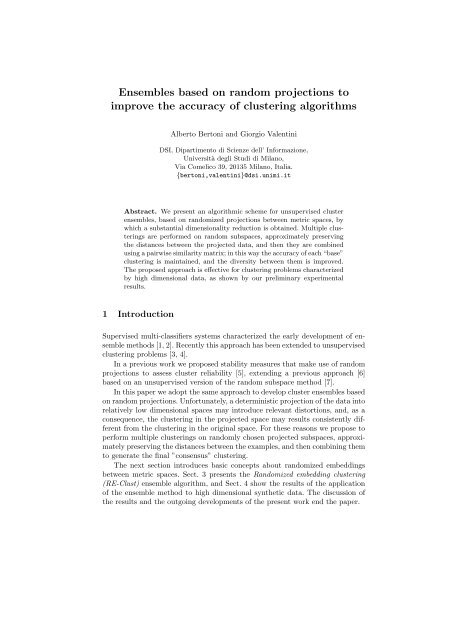

![1) [4] Cos'è un hazard? Uno stallo? Cos'è una pipeline multiple ...](https://img.yumpu.com/16431383/1/190x245/1-4-cose-un-hazard-uno-stallo-cose-una-pipeline-multiple-.jpg?quality=85)
